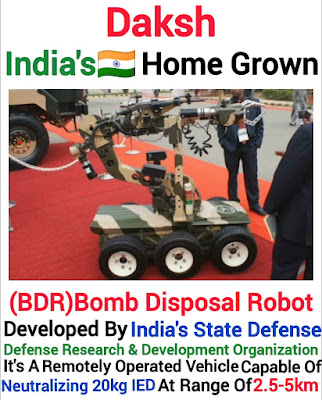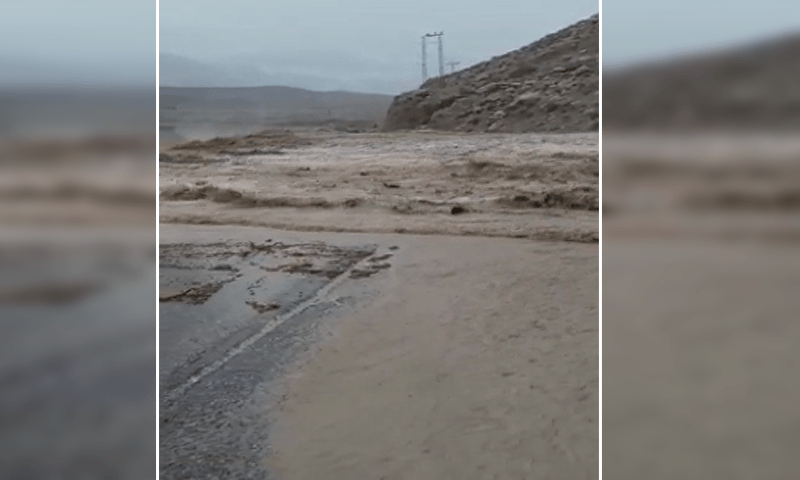India's Daksh Remotely Operated Vehicle (ROV)
Daksh is an electrically powered remotely operated vehicle (ROV) designed and developed by the Indian state-owned Defence Research and Development Organisation (DRDO) at the Research and Development Establishment (Engineers), Pune, India.
Primarily designed to recover improvised explosive devices (IEDs), ROV Daksh can safely locate, handle and destroy all types of hazardous objects. Daksh serves bomb disposal units (BDU) of the army, police and paramilitary forces in handling IEDs and other hazardous materials.
The DRDO transferred its ROV technology for production at Dynalog, Theta Controls and Bharat Electronics.
In 2010, the Indian Army placed a limited-series-production order for 20 Daksh vehicles after extensive trials, testing and acceptance. The first batch of five ROV Daksh was delivered to the Indian Army in December 2011. The ROV was inducted by the Pune City Police Department, India in October 2018.
In January 2017, DRDO announced the development of two robots in the Daksh series, namely Daksh Mini and Daksh Scout.
ROV Daksh main features The remotely operated vehicle is based on a motorised pan-tilt platform. It can be remotely controlled from a range of 500m. The vehicle’s manipulator arm can handle hazardous objects of up to 20kg from 2.5m and 9kg from a 4m distance.
Daksh can climb stairs and negotiates steep slopes. The solid rubber wheels of Daksh can withstand blast impacts. The vehicle can tow suspected platforms and operate continuously for three hours once fully recharged.
ROV Daksh is equipped with multiple cameras, IED handling equipment, nuclear biological chemical (NBC) reconnaissance systems, a master control station (MCS) and a shotgun. The ROV Daksh and MCS are transported by a specially designed carrier vehicle.
IED handling equipment of the remotely operated vehicle
The major task carried out by ROV Daksh is IED handling. The IED handling equipment scans, handles and removes hazardous objects.
The water jet disrupter fitted on the vehicle can safely diffuse IEDs. The vehicle can lift, drag and tow suspected objects away from the area.
The onboard X-ray unit scans horizontal and vertical planes. The unit is equipped with real-time imaging facility with zoom in / out and multiple auto snapshot creation facility. The image processing software allows the users to alter brightness, contrast, sharpness, blurring, negation and mirror settings.
NBC reconnaissance systems
Daksh is equipped with a radiation measurement and automatic control unit (RADMAC) and portable gas chromatograph (PGC) to monitor the contamination level in NBC affected surroundings.
The RADMAC measures neutron dose and INR dose. It can detect X and Gamma rays from 60keV to 2MeV and is equipped with multiple detectors for gamma dose and gamma flash. The dedicated sensor element can detect radiation leaks.
PGC detects the presence of gas and the concentration levels. It displays the results in numeric as well as graphical format. The unit includes a dot matrix printer.
It has a user programmable library of gases with their features, to enable quick detection and determination of contamination levels. PGC unit is also provided with user definable alarm settings and auto peak detection and reporting features.
Master control station (MCS) of the Indian Army’s ROV
The ROV Daksh can be remotely controlled by a single operator using the MCS. The control station has a user friendly interface and advanced controls for managing the multiple operations of Daksh.
The wheeled, trolley-based independently-powered system delivers high mobility in the field. The onboard modern communication systems allow command and control as well as image transmission between Daksh and MCS.
The membrane keypad, touch-screen and joysticks on the MCS allow the operator to run and control the ROV with ease. The touchscreen simultaneously displays four camera inputs with full screen option.
Carrier vehicle
The carrier vehicle is specially designed to carry Daksh, MCS, bomb disposal stores and crew for hazardous disposal operations.
It has air-conditioned compartment with soft interiors. A separate compartment is provided for equipment storage and space is available for bomb disposal stores.
A six-bay lockable rifle rack accommodates weapons of the crew. Either side of the vehicle is provided with rifle port holes for self defence.
The vehicle is also equipped with a refrigerator, foldable ramp, 1KVA generator, battery charger, global positioning system (GPS) and rear view display system.
The vehicle meets the requirements of the bomb disposal units of the armed forces.
Daksh ROV variants
Daksh Mini is fitted with six-axis telescopic manipulator arm with high resolution cameras. It is operated using battery and weighs less than 100kg.
Daksh Scout remotely operated vehicle is controlled from portable operator console with the help of RF. It is capable carrying out silent surveillance both during the day and night.



Comments
Post a Comment